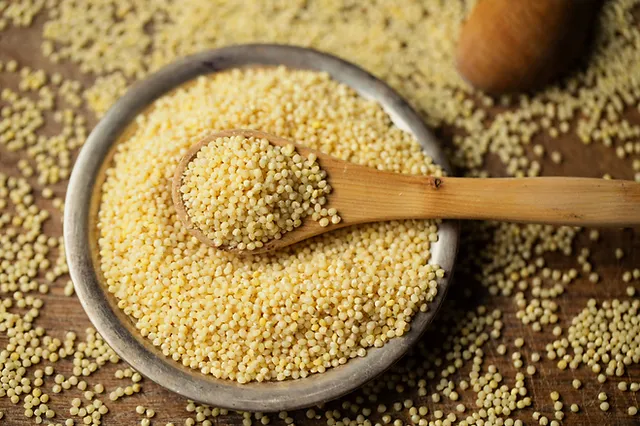Foxtail Millet
Foxtail millet (Setaria italica) is one of the oldest cultivated millets and is a staple food in parts of Asia especially in India and China. Here are some key points about foxtail millet:
Description
- Appearance: It has slender stems with broad grass-like leaves and produces small rounded grains.
- Growth: It is a hardy crop that can grow in a variety of soils and climates typically maturing within 60-90 days.
- Nutritional Value: Foxtail millet is rich in dietary fiber protein and essential minerals like iron and calcium. It is also gluten-free making it suitable for people with celiac disease or gluten intolerance.
Health Benefits
- Digestive Health: High in dietary fiber foxtail millet aids in digestion and helps prevent constipation.
- Weight Management: It has a low glycemic index which helps in managing blood sugar levels and is beneficial for weight management.
- Heart Health: The millet is rich in antioxidants and magnesium which are good for heart health.
- Bone Health: The calcium content in foxtail millet supports bone strength and development.
Culinary Uses
- Traditional Dishes: In India it is used to make dishes like khichdi dosa upma and porridge. In China it s often used to make congee.
- Modern Uses: It s gaining popularity as a health food and is being used in various forms such as flour for baking flakes for breakfast cereals and as a rice substitute in many recipes.
Agricultural Aspects
- Cultivation: Foxtail millet is typically sown in the monsoon season and harvested in the late summer. It requires minimal water and is resistant to pests and diseases making it a sustainable crop.
- Yield: It provides a good yield with relatively low input costs making it an economically viable crop for small farmers.
Environmental Impact
- Water Efficiency: It is a drought-tolerant crop that requires significantly less water than many other staple grains like rice and wheat.
- Soil Health: Millets including foxtail millet help improve soil health by adding organic matter and can be used in crop rotation systems to reduce soil degradation.
Foxtail millet (Setaria italica) is one of the oldest cultivated millets and is a staple food in parts of Asia especially in India and China. Here are some key points about foxtail millet:
Description
- Appearance: It has slender stems with broad grass-like leaves and produces small rounded grains.
- Growth: It is a hardy crop that can grow in a variety of soils and climates typically maturing within 60-90 days.
- Nutritional Value: Foxtail millet is rich in dietary fiber protein and essential minerals like iron and calcium. It is also gluten-free making it suitable for people with celiac disease or gluten intolerance.
Health Benefits
- Digestive Health: High in dietary fiber foxtail millet aids in digestion and helps prevent constipation.
- Weight Management: It has a low glycemic index which helps in managing blood sugar levels and is beneficial for weight management.
- Heart Health: The millet is rich in antioxidants and magnesium which are good for heart health.
- Bone Health: The calcium content in foxtail millet supports bone strength and development.
Culinary Uses
- Traditional Dishes: In India it is used to make dishes like khichdi dosa upma and porridge. In China it s often used to make congee.
- Modern Uses: It s gaining popularity as a health food and is being used in various forms such as flour for baking flakes for breakfast cereals and as a rice substitute in many recipes.
Agricultural Aspects
- Cultivation: Foxtail millet is typically sown in the monsoon season and harvested in the late summer. It requires minimal water and is resistant to pests and diseases making it a sustainable crop.
- Yield: It provides a good yield with relatively low input costs making it an economically viable crop for small farmers.
Environmental Impact
- Water Efficiency: It is a drought-tolerant crop that requires significantly less water than many other staple grains like rice and wheat.
- Soil Health: Millets including foxtail millet help improve soil health by adding organic matter and can be used in crop rotation systems to reduce soil degradation.
Have Questions? Get In Touch!
If you have any questions about our products or services, please feel free to contact us directly or submit a request through our "call back" form.

© 2024, Venkateswara Trading . All rights reserved. Designed by Web Technoedge Solutions Pvt. Ltd.
